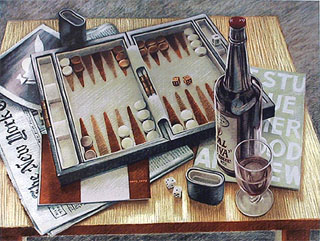|
| Magriel's NYT Columns |
 The second annual New England Backgammon Club Tournament, sponsored by Black and White Scotch, took place last weekend in Cambridge, Mass. Bill Robertie took top honors in a strong international field and so reinforced his standing as the best match player in the region. Ellen Jacoby Lee was the finalist; Mel Drapkin and Jim Wyckoff the semifinalists. In other sections: Roger Low overcame Charles Hesser in the consolation; Kermit Kimball defeated Lord Rennell of Rodd in the last chance; and Scott Hynek won the intermediate division.
The second annual New England Backgammon Club Tournament, sponsored by Black and White Scotch, took place last weekend in Cambridge, Mass. Bill Robertie took top honors in a strong international field and so reinforced his standing as the best match player in the region. Ellen Jacoby Lee was the finalist; Mel Drapkin and Jim Wyckoff the semifinalists. In other sections: Roger Low overcame Charles Hesser in the consolation; Kermit Kimball defeated Lord Rennell of Rodd in the last chance; and Scott Hynek won the intermediate division.
In backgammon, a player is often faced with a choice between two plays: the “big” play, which is constructive but dangerous; and the “small” play, which is safest. An essential element of the game is the inherent tension between these two kinds of plays. Indeed, the mark of a good player is his ability to make an accurate assessment, in each case, of the risks versus the potential gains.
Roger Low, the consolation winner, demonstrated this ability in the diagrammed position, taken from his finals match against Charles Hesser. Black (Low) had already doubled and was a substantial favorite until he was hit on his 2-point by White (Hesser).
|
| Black to play 5-1. |
The alternative is to keep a man on the 8-point exposed to a direct 6-shot by White. Because of White’s strong 5-point home board, Black may feel that his play is too “big,” that is, unnecessarily risky. Furthermore, what would Black gain by leaving a man open? Even if White fails to roll the dreaded 6, Black is highly unlikely (only 4-4’s or 6-6’s) to cover this man next roll.
Low, however, was not deceived by this line of reasoning, and correctly chose the alternative play, bar/20, 4/3. He made an entirly different evaluation of the player’s risks and rewards. In fact, his main conclusion is remarkable — the risk (of being hit) is an illusion!
|
|
|
Black is powerless to prevent White from rolling a 6 — therefore he must work on the assumption that White will not roll a 6, and position himself accordingly. Keeping a spare man on the 8-point (by playing 4/3) gives Black a better builder distribution with which to attack White on the 2-point next roll. Stacking a third man on the 7-point (by playing 8/7) significantly reduces Black’s chances (by more than 50 percent) of either making the 2-point or a full prime.
Rollout
 Tom Keith 2013 |
|
Money play White owns 2-cube Black rolls 5-1 1296 games with VR Checker play: 2-ply Cube play: 3-ply Red |
| 5-1: | Game | G | BG | Equity | ||||
| 1 | bar/20, 8/7 |
W L |
.5812 .4188 |
.0597 .0700 |
.0017 .0005 | +0.0072 |

| (a) |
| 2 | bar/20, 4/3 |
W L |
.5449 .4551 |
.0563 .1621 |
.0018 .0010 | −0.0942 | (0.1014) | (b) |

|
|

